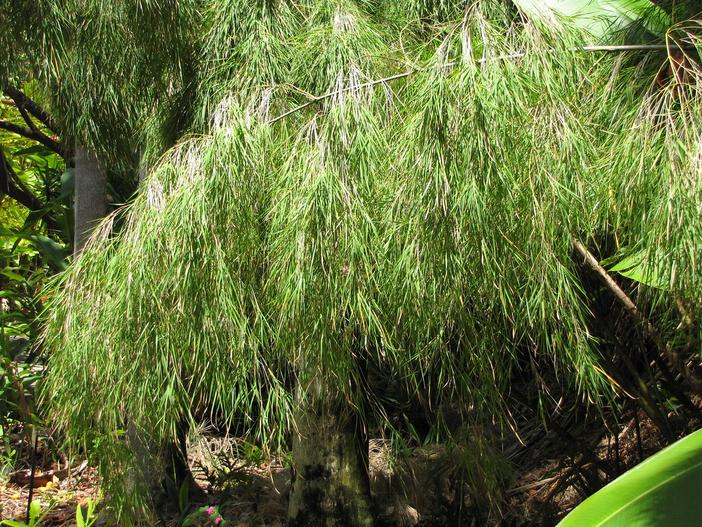Mexican Weeping Bamboo
(Otatea acuminata)
Mexican Weeping Bamboo (Otatea acuminata)
/
/

Forest and Kim Starr
CC BY 2.0
Image By:
Forest and Kim Starr
Recorded By:
Copyright:
CC BY 2.0
Copyright Notice:
Photo by: Forest and Kim Starr | License Type: CC BY 2.0 | License URL: https://creativecommons.org/licenses/by/2.0/ | Uploader: Starr Environmental | Publisher: Flickr























Estimated Native Range
Summary
Otatea acuminata, commonly known as Mexican Weeping Bamboo, is an evergreen perennial grass native to the moist forests and rocky slopes in the mountains of Mexico. It is a fast-growing clumping bamboo that can spread 1–2 feet (0.30–0.61 m) in each direction yearly. The weight of the leaves causes the long thin culms to bend, creating a weeping effect. In its native habitat, the plant can reach over 25 feet (7.6 m) in height and width, forming dense thickets. The foliage is a lush green, and the plant does not typically flower or set seed in cultivation.
Mexican Weeping Bamboo is valued for its graceful appearance and adaptability to a range of garden settings. It is often used as a focal point in subtropical and temperate climate gardens, providing movement and texture. Its drought tolerance once established makes it a low-maintenance choice for gardeners. It can be grown in pots, where it reaches around 6 feet (1.8 m) tall, making it suitable for patios and smaller spaces. This bamboo is also used for creating privacy screens or as a windbreak due to its dense growth habit. Cultivation requires full sun to part shade, low to medium water once established, and well-draining soil. It is particularly well-suited to Southern California’s climate and soil. Unlike many bamboos, it is not invasive and maintains a tidy clump form. The leaves remain green without browning at the tips, even under less than ideal conditions. Propagation is straightforward by dividing the root ball, and thinning the culms can enhance its delicate appearance.CC BY-SA 4.0
Mexican Weeping Bamboo is valued for its graceful appearance and adaptability to a range of garden settings. It is often used as a focal point in subtropical and temperate climate gardens, providing movement and texture. Its drought tolerance once established makes it a low-maintenance choice for gardeners. It can be grown in pots, where it reaches around 6 feet (1.8 m) tall, making it suitable for patios and smaller spaces. This bamboo is also used for creating privacy screens or as a windbreak due to its dense growth habit. Cultivation requires full sun to part shade, low to medium water once established, and well-draining soil. It is particularly well-suited to Southern California’s climate and soil. Unlike many bamboos, it is not invasive and maintains a tidy clump form. The leaves remain green without browning at the tips, even under less than ideal conditions. Propagation is straightforward by dividing the root ball, and thinning the culms can enhance its delicate appearance.CC BY-SA 4.0
Plant Description
- Plant Type: Grass
- Height: 8-15 feet
- Width: 8-15 feet
- Growth Rate: Moderate
- Flower Color: N/A
- Flowering Season: Non-Flowering
- Leaf Retention: Evergreen
Growth Requirements
- Sun: Full Sun, Part Shade
- Water: Medium
- Drainage: Fast
Common Uses
Erosion Control, Low Maintenance
Natural Habitat
Moist forests and rocky slopes in the mountains of Mexico
Other Names
Common Names:
Scientific Names: , Otatea acuminata, Otatea acuminata subsp. aztecorum, Yushania aztecorum, Otatea aztecorum, Otatea acuminata subsp. acuminata, Arundinaria acuminata, Yushania acuminata,
GBIF Accepted Name: Otatea acuminata (Munro) C.E.Calderón ex Soderstr.